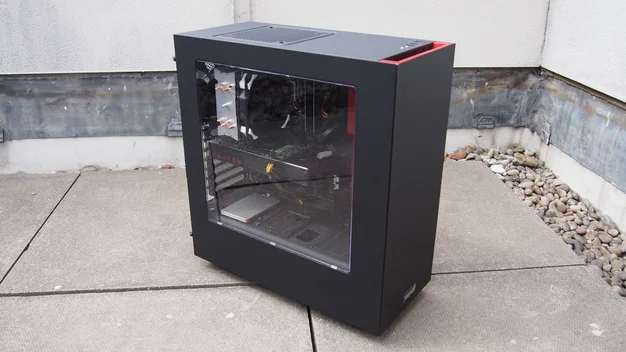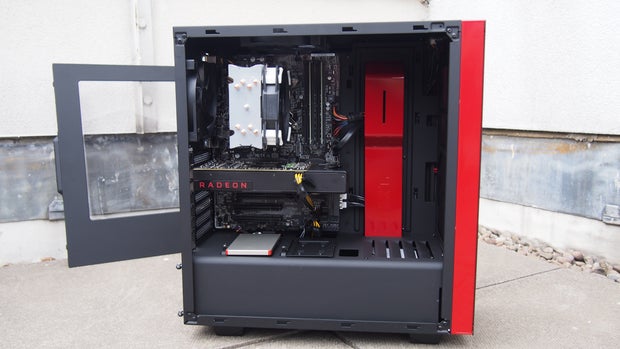Chillblast Fusion Everest review – meet the GPU from the PlayStation Neo

Powered by AMD’s brand-new Radeon RX 480 GPU, the Chillblast Fusion Everest is immensely potent for its price
Specifications
Processor: Quad-core 4.4GHz Intel Core i5-6600K, RAM: 8GB DDR4, Front USB ports: 2x USB3, Rear USB ports: 2x USB2, 2x USB3.1, 1x USB Type-C, Total storage: 250GB SSD, 1TB SSHD, Graphics card: 8GB AMD Radeon RX 480, Display: None, Operating system: Windows 10
Nvidia isn’t the only one with big new graphics cards going on sale. AMD is about to launch the first of its Polaris architecture cards, the Radeon RX 480, promising vastly improved power efficiency and slick performance from its 14nm FinFET process and nippy 1,266MHz core clock. A similar GPU, though clocked at a lower speed, is being widely touted as the heart of the upcoming PlayStation Neo (or PS4K) console.
The RX 480 isn’t directly competing with the GeForce GTX 1080 and 1070, though – whereas Nvidia’s premium offerings are aimed at top-end enthusiasts, the RX 480 is more about bringing 4K and VR gaming to the masses, even if that doesn’t involve superlative frame rates. This is evident in the price; the 4GB and 8GB models will cost just $200 and $220 respectively. That’s about £149 and £164, though expect the final UK price (unavailable at the time of writing) to vary due to Brexit-related currency shenanigans.
In any case, the RX 480 paves the way for pre-built systems with potentially much better price-to-performance ratios than previous Radeon cards. One such system is the Chillblast Fusion Everest, which matches the 8GB version of AMD’s GPU with an overclocked 4.4GHz Intel Core i5-6600K processor, 8GB of RAM and heaps of storage all for a rather attractive £900.
Performance
Of course, I wasted no time jumping into our benchmark tests to see what AMD’s card could do. Early results in Dirt Showdown were positive; at Ultra settings and 1,920×1,080 resolution, the Fusion Everest averaged a lithe 131fps. At that all-important 4K resolution, it did drop to 55fps, but this was still more than smooth enough for Dirt’s chaotic racing. It’s not strictly necessary, but I did break through the 60fps barrier (63fps, to be precise) simply by dropping shadow quality and ambient occlusion from Ultra to High.
Metro: Last Light Redux, as it always does, presented a much tougher challenge. At 1,920×1,080 with Very High settings, the Fusion Everest managed a very playable 45fps average, but switching to 4K meant it could only squeeze out 10fps. It took quite a bit of tweaking the settings and re-running the test until we could get a good frame rate, ultimately settling on Medium quality with SSAA and advanced PhysX disabled, texture filtering reduced to AF 4X and both motion blur and tessellation set to Normal, which produced a 50fps average.
If that sounds like a complaint, it isn’t really – for £900, being able to handle 4K gaming without having to utterly gut graphical quality is a huge achievement. The Fusion Everest will cope well with VR, too, as it received a ‘VR Ready’ rating (the highest available) in Valve’s SteamVR benchmark tool.
The rest of the hardware pulls its weight as well. In our 2D application benchmarks, the Fusion Everest’s overclocked CPU helped it to an image score of 133, a video score of 134, a multitasking score of 143 and 138 overall – high marks all round. Interestingly, both these scores and the gaming benchmarks results are extremely close to those of the Best Buy-winning Scan 3XS Z170 Performance GTK6; equipped with the same Core i5-6600K and a 4GB Nvidia GTX 970, Scan 3XS’s rig costs over £100 more, making the Fusion Everest an even bigger bargain.
There’s a lot more to like about this PC besides its performance. It comes in an absolutely lovely matt-finish case, which is as tasteful on the outside as it is tidy on the inside. Its solid front panel means there’s nowhere to put a 5.25in drive, which is a bit unfortunate, but there are a couple of additional spots for extra 2.5in and 3.5in drives.
Storage and ports
Speaking of which, you get some superb storage in the Fusion Everest. In the AS SSD benchmark, the 250GB SK Hynix drive recorded fast sequential read and write speeds of 522MB/s and 454.62MB/s respectively, while the 1TB SSHD is a step up from the purely mechanical hard drives I normally see accompanying the SSD in powerful gaming systems.
As for external ports, you get two USB3 ports on the front plus two USB2, two USB3.1 and one USB Type-C port on the rear, in addition to two PS/2 sockets, the standard three 3.5mm audio jacks and an Ethernet port. We’d have liked a couple more USB ports either at the front or the back, but the inclusion of the fastest USB3.1 and Type-C platforms helps quell any disappointment. There’s a respectable variety of video outputs too, including two HDMI connectors, three DisplayPorts, one dual-link DVI-D and one VGA output.
Back on the inside, there’s definitely scope to add more components (like an audio or Wi-Fi card, or another GPU) in the future. The motherboard offers one spare PCIe x16 slot (even though, unlike the slot occupied by the RX 480, it only runs at x4 speed), two PCIe x1 slots and two legacy PCI slots, plus a total of four RAM slots (two of which are free) and even an M.2 port for premium storage.
Conclusion
If you want a PC that can wring the absolute best performance out of a single-card setup, then I’d still suggest going for something with one of Nvidia’s newest GTX models, but otherwise I suspect RX 480-equipped systems like the Fusion Everest will be your best bet for 4K and VR capability under £1,000. This PC in particular is a fantastically balanced rig, and while it’ll be worth waiting to see what other builders can produce with the same AMD card, I’d be remiss to grant it anything less than a Best Buy award.
Returning briefly to the PlayStation Neo angle, the new GPU looks highly-capable and should produce some stunning-looking graphics. The optimisation possible on a fixed hardware specification should more than offset the lower clock speed on the console, rumoured to be just 911MHz. However, even then the console may struggle to produce 60fps gaming at a native 4K resolution and some upscaling shenanigans could be in order.
| Core specs | |
|---|---|
| Processor | Quad-core 4.4GHz Intel Core i5-6600K |
| Processor socket | LGA1151 |
| RAM | 8GB |
| Memory type | 2,133GHz DDR4 |
| Maximum memory | 64GB |
| Motherboard | Asus Z170-K |
| Motherboard chipset | Intel Z170 |
| Ports and expansion | |
| Front USB ports | 2x USB2 |
| Rear USB ports | 2x USB2, 2x USB3.1, 1x USB Type-C |
| Other ports | 2x PS/2, 1x M.2 |
| Networking | Ethernet |
| Case type | Mid tower |
| Case dimensions HxWxD | 445x432x200mm |
| PCI (free) | 2 (2) |
| PCIe x1 (free) | 2 (2) |
| PCIe x16 (free) | 2 (1) |
| Serial ATA (free) | 6 (4) |
| Memory slots (free) | 4 (2) |
| Drive bays 2 1/2″ (free) | 2 (1) |
| Drive bays 3 1/2″ (free) | 2 (1) |
| Drive bays 5 1/4″ (free) | 0 |
| Storage | |
| Total storage | 250GB SSD, 1TB SSHD |
| Memory card reader | None |
| Optical drive type | None |
| Graphics | |
| Graphics card | 8GB AMD Radeon RX 480 |
| Graphics/video ports | 2x HDMI, 3x DisplayPort, 1x dual-link DVI-D, 1x HDMI |
| Sound | |
| Sound card | Onboard |
| Sound card outputs | Line out |
| Speakers | None |
| Display | |
| Display | None |
| Native resolution | N/A |
| Inputs | N/A |
| Other hardware | |
| Keyboard | None |
| Mouse | None |
| Extras | None |
| Software | |
| Operating system | Windows 10 |
| Operating system restore option | Windows 10 restore |
| Buying information | |
| Warranty | Five years RTB including two years collect and return |
| Price including delivery (inc VAT) | £900 |
| Part Code | Fusion Everest |









